The Scorpion Fish family (Family Scorpaenidae) is huge. It includes, Lion Fish, Devil Fire fish, Paper Fish, Indian Walkman, False Stone Fish, Stone Fish and of course, the 50 varieties of Scorpion fish found on our reefs.
Scorpion fish eggs are fertilised internally, but they are laid before they hatch, and once hatched the young scorpion fishes fend for themselves. Initially juveniles are pelagic, floating wherever the current takes them. Preyed on by sharks and pelagic predators, many of them do not survive to adulthood. Those that do survive become masters of camouflage, and readily take on the colouring and texture of their surroundings.
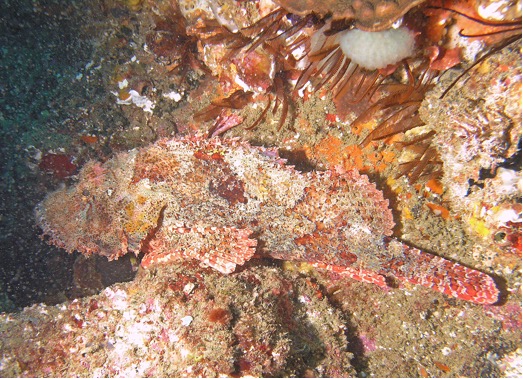
Raggy Scorpion Fish (Scorpaeonopsis venosa)
The Raggy, Small Scale, and Hump Back Scorpion fishes are the most common varieties found in the Indian Ocean East Coast and Islands. They have long bodies, well-developed pectoral fins and shed sand and debris. They have the most astonishing golden eyes with iridescent whirls and tiny black threads. Their eyes are close together and bulge outward from a bony forehead.
They will raise their dorsal spines if they perceive an attack. They secrete a protein poison, which can be broken down either with acid or with heat. If you get stung, the closest hot acid is usually your dive buddy’s pee. It works. They are fascinating predators, lying in wait until a fish swims within range. Then they push upwards and the mouth engulfs a fish almost as large as the scorpionfish, while water is expelled through the gills.
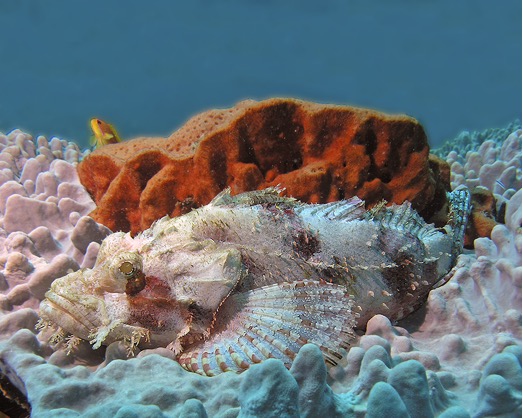
Small Scale Tasselled Scorpion Fish (Scorpaenopsis oxycephala)
Stone fishes are rarely spotted at Sodwana Bay, but there are a large number to be seen in Mauritius. They have an almost square body, a disproportionately large head and wide apart eyes set in a depressed and flattened forehead. Their skin is leathery and warty and they do not have scales.
Mainly found on reefs with rocky bottoms and sandy covers they have very large colourful pectoral fins which they flash if threatened or disturbed. Then they use their powerful tail to propel themselves upwards, the huge mouth opens, and the fish disappears. They too swallow water with the prey which they later expel though their gills.
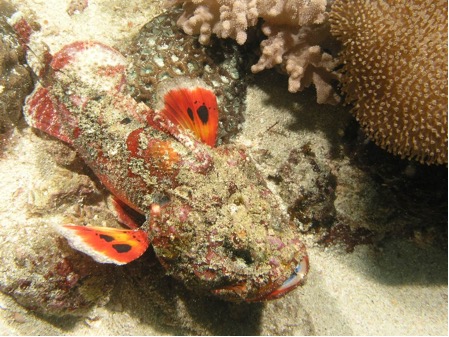
Indian Walkman (Inimicus Filamentosus)
The photo above shows one of the rarest and most bizarre-looking Scorpion fishes; he looks very like a Stone Fish – covered in sand and debris, completely invisible unless disturbed.
I shone my torch into a rock near a crevice and got a shock when it exploded into this furious character, mouth open, bright red with rage, with fin flashes fully extended. He “walked” on his fan-like pectoral fins, mouth opening and closing with rage and huffed off into a crevice. We identified him as an Indian Walkman (Inimicus Flamentosus). They are extremely rare at Sodwana but more plentiful in Mauritius, and often mistaken for a Stonefish.
The Stone fish is always completely covered in sand and debris, making him nearly impossible to spot and keeping him safe from predators. A poor swimmer, he relies on this to survive.
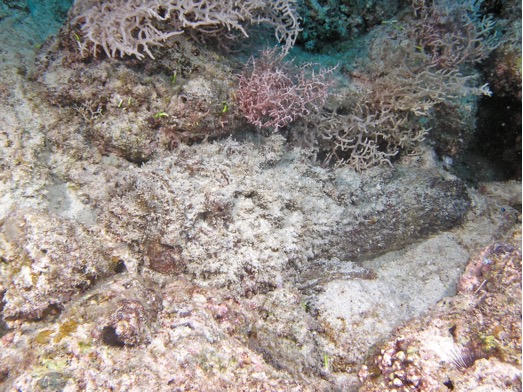
Stone Fish (Synanceia veruscosa)
He waits until the unsuspecting prey has landed on him before he opens his enormous mouth and sucks it down.
He is also the most venomous fish in the sea. If a swimmer steps on him barefoot, he will inject deadly venom through his raised dorsal spines. The foot pressure squeezes out the toxin hidden in glands beneath the dorsal spines and it spreads rapidly through the victim’s system. The pain is intolerable and death is likely within an hour of contact without immediate treatment with anti-venom or very hot water.
How to tell the difference? A good rule of thumb for distinguishing between Scorpion fish and Stone fish – if you see it, it’s a Scorpion Fish, if you don’t, it was probably a stone fish… but if you stepped on it you wouldn’t care.
The weedy scorpionfish scorpionidae rhinopious is even more rare, and I have seen only three of them in 25 years. They blend so well with their surroundings they are almost invisible.
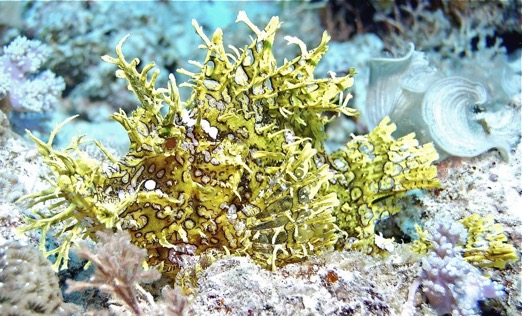
Weedy Scorpionfish (Rhinopias Frondosa)
Close relatives are the little jeweled predators the leaf fish or scorpion paper fish (taenianotus triacanthus). These little guys are always exciting to see, as they are fairly uncommon. Photographers love them and divers are enchanted by them. The universal leaf fish signal of swaying-hand-on-palm-of-hand spans the globe.
Leaf fishes come in a huge variety of colours but they are all part of the same family. There does not seem to be any reason for colour changes other than camouflage, but since some come in brilliant pink, others in mottled browns and blacks and others in whites and yellows, the colour variations seem to be random. It’s hard to believe that a bright pink leaf fish could possibly believe it was hidden from its prey, but they may not look pink to a shrimp or a small fish. They can even create a mottled effect using mottled colour camouflage, making themselves look like algae or like a rock or coral. They do not have scales and their bodies are covered in prickly papillae, like a porcupine fish.
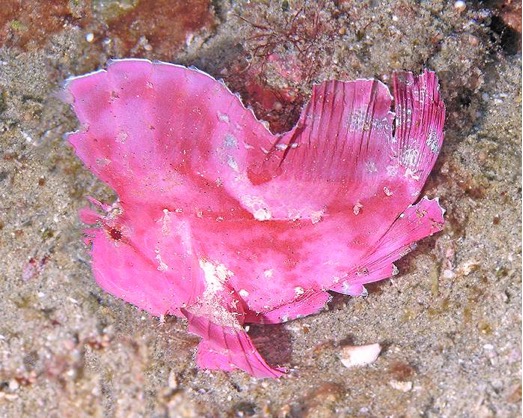
Scorpion paper fish or leaf fish (Taenianotus triacanthus)
Dive guides love them as they are fairly territorial and can easily be found again once spotted. You will normally see a leaf fish squatting staunchly down in a crevice with its pectoral fins gripping the edges of its protected spot like tiny hands and feet, clamped there and completely unmoving . Don’t be fooled. It is not hanging on to stop itself from being swept away; it is hunting. If you watch and wait, it starts to sway, although there is no current. It swings from side to side and turns imperceptibly as it sways, eyes moving constantly. Then when an unsuspecting prey comes within reach, usually larvae or small fish up to half its own body size, occasionally crustaceans or shrimps it hoovers them right up.
Their eyes are set on either side of the head but because of the narrow head they do not see straight ahead and this is one of the reasons why they sway; they need to get depth perception before pouncing. For added concealment they have a bead around their mouths, consisting of fine irregular appendages which break up the shape of the mouth to fool prey.
They are laterally compressed, so from in front they look like a stick with feet, with huge splayed pectoral fins which enable them to walk when they want to move small distances. The dorsal fin is soft and often quite spectacular and is bonded to the caudal fin. This combination gives it a fin that is quite often almost the same size as the body.
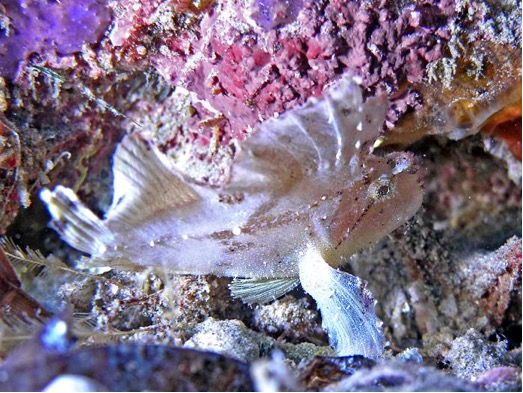
Scorpion paper fish or leaf fish (Taenianotus triacanthus)
They can be found at almost any depth, from 5m right down to 120m and because their prey is so varied, they can live in almost any conditions, but they prefer to be in areas where there is current sweeping in small invertebrates, which stick in the sea weeds and among the rocks of its preferred hiding places.
The spines, like those of its relatives the Scorpion Fish (Scorpaenidae) are venomous, and if you put a hand down on a leaf fish you would be stung by one of the concealed venomous barbs in its dorsal fin. The poison is painful but not fatal. A sting from a leaf fish can be treated with antihistamine cream.
Then there are the Devil Firefish, spectacular, plentiful and deadly.(Scorpaenidea Pterois Miles)
Opulent, dramatic and often obligingly posing for photos the spectacular Devil Firefish is often the first undersea creature that a new diver remembers and can recognise. Hovering over the sand in a sheltered part of the reef, these guys are nocturnal, hunting at night and resting up during the day. Their poisonous spines protect them from predators and their brilliant and bizarre colouring helps camouflage them against the reef.
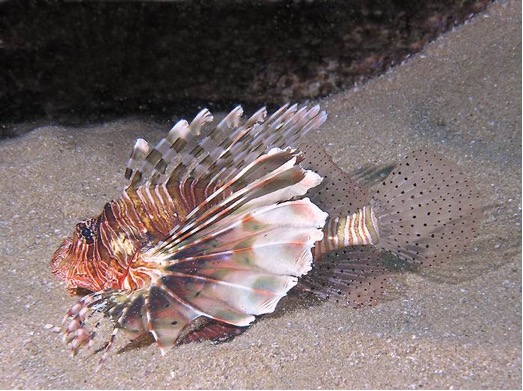
Zebra Lionfish (Scorpaenidea Pterois Miles)
They are often confused with the Lion Fish (Pterois volitans), which is native to the Atlantic, while the Devil Firefish makes its home on the East African Coast and in the Indian Ocean. Both species occur in parts of the Indo-Pacific.
There are several species of Devil Firefish, but the most common on the East African Coast is the (Pterois Miles) or winged sailor. The spines of the Devil Firefish are venomous and a sting can be extremely unpleasant if not treated immediately with a protein poison antidote like acid or heat.
Symptoms can include intense pain, throbbing or blistering, although I was once stung by one through the knee of my wetsuit and felt no ill effects at all. Perhaps the venom was dispersed into the Lycra. Different people have reported headaches, vomiting, breathing difficulties and even loss of consciousness.
Because of their venomous spines they tend to out-breed other species in areas under pressure and there is concern that the numbers of these creatures is growing where there has been over-fishing.
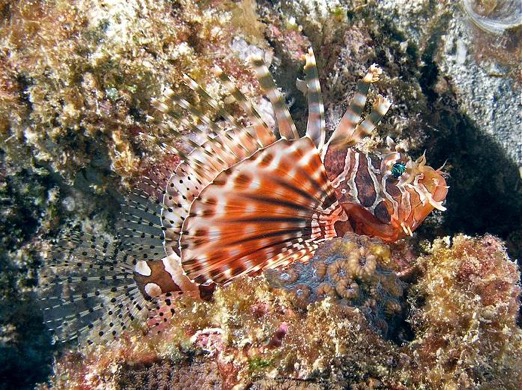
White lined Firefish (Dendrochirus Miles)
They have a varied diet and a voracious appetite, eating small crustaceans and fish, sometimes herding fishes with their spectacular wing-like pectoral fins and then engulfing the prey with their huge mouths. Watching them hunt is incredibly rewarding. I have seen them sucking in water through their mouths and blowing it across the reef, hunting for crustaceans that might be buried beneath the sand.
Male lionfish are fiercely territorial, and will defend their territory against other species and other lion fish – and even divers. They raise their poisonous fins and thrust them forward ferociously and it takes a lot of courage not to back off and steer well clear of them in this mode.
When they are ready to mate, the females become almost bridal pale in appearance and the male darkens with lust. A single male will have a harem of three or four females. As soon as the female is ready to mate she rises in the water, hotly pursued by the randy male. Near the surface the female releases her eggs and the male spreads his sperm. Then they revert to normal colour and sink back down to the reef. . Between 3000 and 30 000 eggs are dispersed and fertilised. The young larvae hatch after 36 hours, and they begin to feed immediately on microscopic organisms, growing to 1 cm after 36 hours. From there their growth rate is rapid.
They appear to be relatively safe from predation, although some have been found in the bellies of sharks caught in the Natal Sharks Board nets. Possibly the sharks are immune to their poison.
Words: Jill Holloway
Pics: David Holloway
Copyright: Ocean Spirit
www.osdiving.com




































